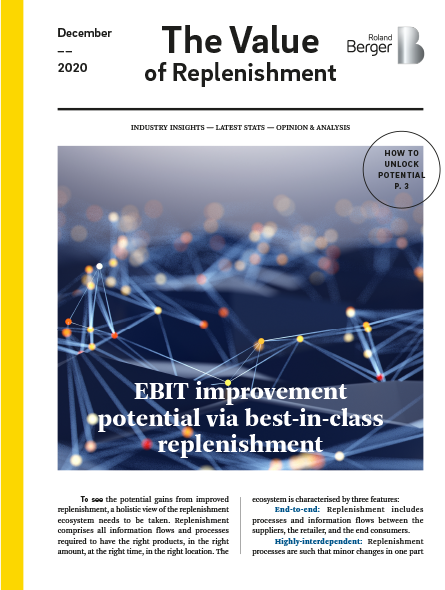The value of replenishment
![{[downloads[language].preview]}](https://www.rolandberger.com/publications/publication_image/656_roland_berger_value_of_replenishment_cover_download_preview.png)
In this paper, we highlight the potential of replenishment and how a best-in-class set-up can deliver significant EBIT improvement.


By Olga Talanova and Nicolas Wüthrich
A push towards direct-to-consumer, omni-channel, and digitisation has a lock on the retail and consumer goods industry. One fundamental enabler that is often overlooked or taken for granted is replenishment. It comprises all information flows and processes required to have the right products, in the right amount, at the right time, in the right location. A best-in-class approach to replenishment can serve as a backbone for a company's aspiration to become a truly digital player and unlock significant EBIT contributions. This involves an integrated organisational and system set-up as well as continuous improvement of algorithms and management of key parameters, underpinned by cross-functional collaboration and incentives. In this paper we provide a new perspective on how a best-in-class replenishment set-up can deliver significant EBIT improvement and outline six key principles of such a set-up.

To see the potential gains from improved replenishment, a holistic view of the whole replenishment ecosystem needs to be taken. Replenishment comprises all information flows and processes required to have the right products, in the right amount, at the right time, in the right location. The ecosystem is thereby characterized by three features: end-to-end (i.e. from supplier to end consumer), high degree of interdependence (i.e. minor changes in one part can have major impact in other parts of the system) and physical as well as virtual aspects (e.g. physical picking set-ups and master data management).
Replenishment is seldom seen as a key lever for EBIT improvements by executives within sales-focused organisations. However, replenishment done rightly (or wrongly) can affect revenue as well as costs via multiple levers:
Read our paper to see how a best-in-class replenishment approach looks like and how it can unlock these levers.
![{[downloads[language].preview]}](https://www.rolandberger.com/publications/publication_image/656_roland_berger_value_of_replenishment_cover_download_preview.png)
In this paper, we highlight the potential of replenishment and how a best-in-class set-up can deliver significant EBIT improvement.